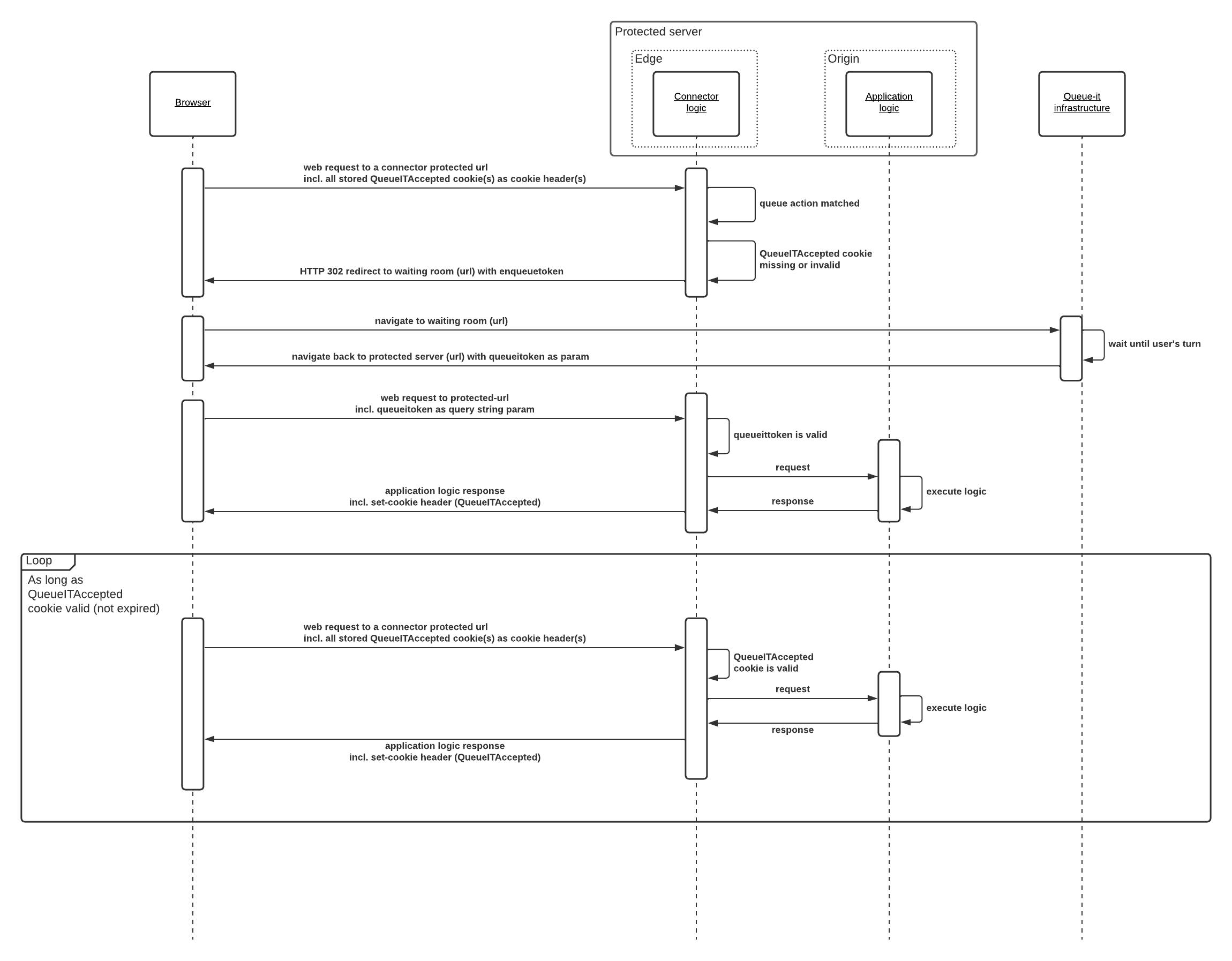Queue-it's Tencent Connector v4 uses Tencent Cloud to integrate a Tencent protected WebServer with Queue-it.
This page is intended to give a high-level technical overview of the Tencent Connector v4. To prevent malicious actors from compromising the security of our customer's high-profile sales and registrations, we host our in-depth Connector v4 documentation in private repositories.
If you need more detailed integration documentation than this page offers, connect with one of our technical experts who can understand your use case and determine the optimal setup for your tech stack.
The following diagram shows the Queue-it logic with an edge Connector.
- User requests a page.
- The validation method sees that user has no Queue-it session cookie and no Queue-it token and sends him to the correct waiting room with a valid token based on the configuration.
- User waits in the queue.
- User is navigated back to your website, now with a valid token.
- The validation method validates the token and creates a Queue-it session cookie.
- The user browses to a new page and the Queue-it session cookie will let him proceed without queuing again.
You can read more about Queue-it's edge compute integrations on our blog, and can find the full list of integrations on our Connectors page.

To integrate using the Queue-it Tencent Connector v4, you will need:
- An active Queue-it account
- An active Tencent account
- Queue-it admin available (Someone with GO Queue-it Platform access and familiarity with the account configuration settings)
- Tencent CDN and EdgeOne admin available (Someone with access to the customer Tencent Cloud Control account who is also familiar with existing CDN and EdgeOne configurations (rule engine, edge functions, etc.))
- Tencent V4 Connector Download Access (Tencent CDN admin must have access to the secure Queue-it V4 Connector GitHub repository, which is not publicly accessible)
- A non-production Tencent CDN configuration that can be used for implementing and testing the new Queue-it Tencent Connector.
The Tencent Connector consists of the following components:
- Queue-it EdgeOne – code provided by Queue-it that enables the waiting room protection
- Edge Functions Variables – these variables hold key values that are used by EdgeOne
- Edge Functions Triggers – triggers that define the scope of EdgeOne protection
- Rule Engine – enables EdgeOne to perform actions like IP address checks, allowing specific IPs to bypass the queue
- Queue-it Integration Configuration – configuration information (JSON format) is created in the GO Queue-it Platform using actions & triggers setting. Currently, the auto-pull method is not supported, so you must hardcode this configuration into the code uploaded to EdgeOne. This means that you need to update the code each time you change your configuration settings.
- Configure waiting rooms, actions, and triggers in Queue-it and create a configuration file
- Create EdgeOne
- Set up Tencent Connector
- Create Engine Rules
Waiting rooms and their protection scope are created and configured in the GO Queue-it Platform and server-side (KnownUser) configuration information must be propagated to the Tencent environment for real-time access by the Queue-it Worker. When an integration configuration is saved (published) in the GO Queue-it Platform, the server-side configuration settings are packaged into a server-side JSON file and positioned on the Queue-it server, ready for secure downloading. Propagation of these settings (JSON) to the Cloudflare environment is performed automatically when the Queue-it integration configuration is published.
Queue-it's actions and triggers framework gives you a high degree of flexibility in determining what aspects of your site are covered by the virtual waiting room (see How Queue-it Works).